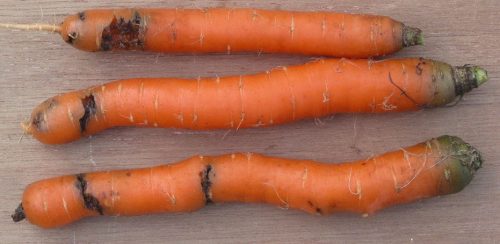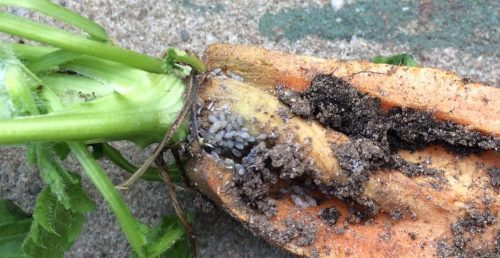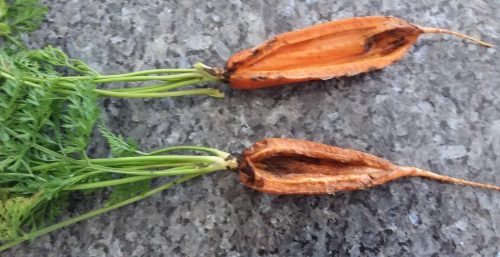Carrot is a domesticated form of wild carrot. There are varieties for harvest in summer and in winter.
You are viewing the mobile-adapted version of the page.
The one for tablets, laptop and desktop also provides general information, such as origin and cultivation.
Carrot (Daucus carota subsp. sativus) – a domesticated form of wild carrot (Daucus carota). There are varieties for harvest in summer and in winter. Carrots for winter use can be sown from April to the end of June. These carrots sown in April can sometimes be harvested as early as late September. Carrots for winter use grow larger than the variety for use in summer. Because carrot seed is very fine, it is also sold as seeds pills and seed bands. Carrots like light soils, in heavy clay the root branches (wonky carrots).
Carrots like to be in full sun. Water regularly, which ensures regular root growth. Suddenly too much water after a period of drought causes the root to burst. Cover the roots with soil when the top of the root is above the ground. Carrots can suffer from the carrot fly, which lays eggs around the plant. The larvae eat their way through the carrots. Insect-proof mesh keeps carrot flies at bay.
Bugs

Pierced roots, tunnels and rust-colored streaks on the root: carrot fly (Chamaepsila rosae).
Leaves yellow, wilt and die, the roots branch sharply, become bushy and elongated dark spots appear on the roots: Northern root lesion (Pratylenchus penetrans).

Roots lag behind in growth and there are white-gray ap
Tunnels and holes in carrots: Wireworm (Agriotes spp.) – larvae of click beetles.
Carrot does not grow, growths on the root, root system shows many small root knots (galls): Northern root-knot nematode (Meloidogyne hapla).
Delayed growth, insufficient length growth of carrots, nodules at the ends of roots: Root knot nematode (Meloidogyne fallax).
Fungi & diseases

Leaf yellowing and turning brown; black, sunken spots on the carrot: black rot (carrot) – (Alter
Greenish-brown spots develop on the foliage, followed by characteristic yellow edge: Alternaria Leaf Blight (Alter
Foliage is covered with a thin gray fungus: powdery mildew (Erysiphe graminis).
Other

Instead of one root, the root branches out: wonky carrot. Branching is caused by heavy clay soil, which interferes with normal growth.
The carrots become soft and remain pale: potassium deficiency.

Cracked open carrots: a period of drought was followed by a lot of rain. Uneven water supply has led to irregular growth.

